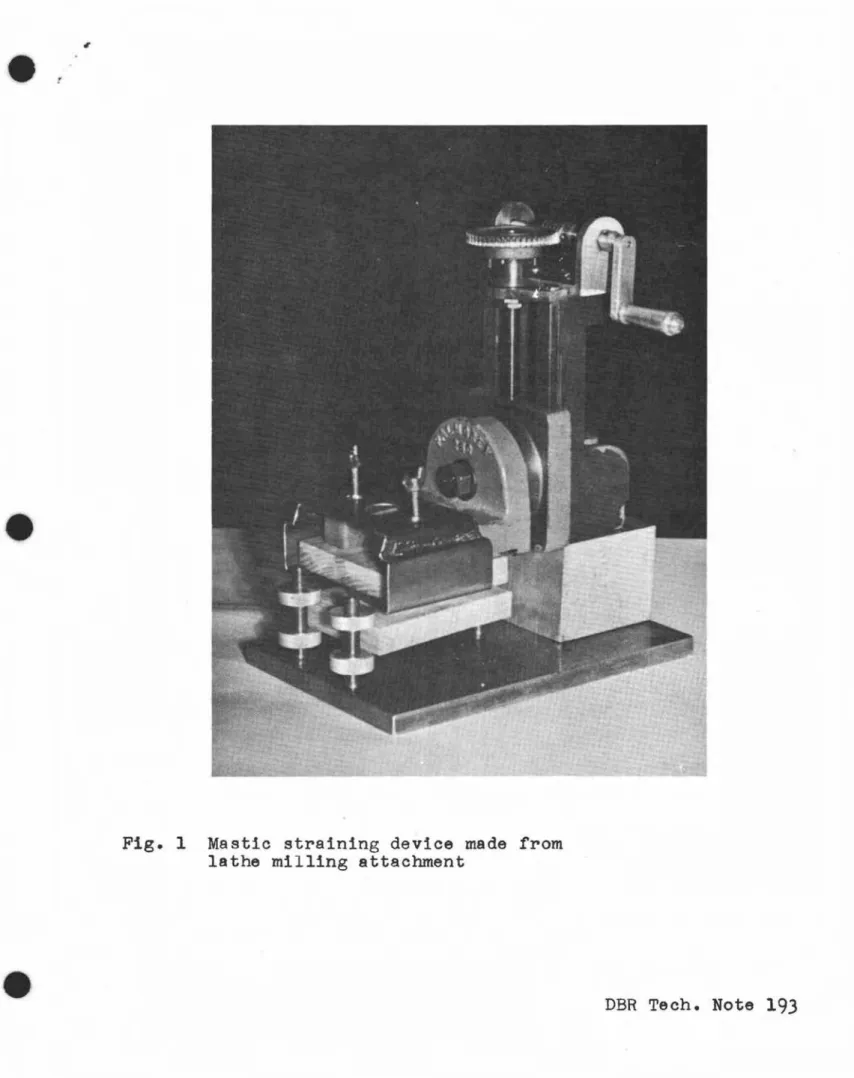Publisher’s version / Version de l'éditeur:
Technical Note (National Research Council of Canada. Division of Building Research), 1955-01-05
READ THESE TERMS AND CONDITIONS CAREFULLY BEFORE USING THIS WEBSITE.
https://nrc-publications.canada.ca/eng/copyright
Vous avez des questions? Nous pouvons vous aider. Pour communiquer directement avec un auteur, consultez la première page de la revue dans laquelle son article a été publié afin de trouver ses coordonnées. Si vous n’arrivez pas à les repérer, communiquez avec nous à PublicationsArchive-ArchivesPublications@nrc-cnrc.gc.ca.
Questions? Contact the NRC Publications Archive team at
PublicationsArchive-ArchivesPublications@nrc-cnrc.gc.ca. If you wish to email the authors directly, please see the first page of the publication for their contact information.
NRC Publications Archive
Archives des publications du CNRC
For the publisher’s version, please access the DOI link below./ Pour consulter la version de l’éditeur, utilisez le lien DOI ci-dessous.
https://doi.org/10.4224/20359127
Access and use of this website and the material on it are subject to the Terms and Conditions set forth at
Straining Device for Tests of Plastic Caulking Materials
Ishii, M.
https://publications-cnrc.canada.ca/fra/droits
L’accès à ce site Web et l’utilisation de son contenu sont assujettis aux conditions présentées dans le site LISEZ CES CONDITIONS ATTENTIVEMENT AVANT D’UTILISER CE SITE WEB.
NRC Publications Record / Notice d'Archives des publications de CNRC:
https://nrc-publications.canada.ca/eng/view/object/?id=4808ece8-8a2b-46ba-a8a0-9a2964931050 https://publications-cnrc.canada.ca/fra/voir/objet/?id=4808ece8-8a2b-46ba-a8a0-9a2964931050
NATIONAL RESEARCH COUNCIL OF CANADA
DIVISION OF BUILDING RESEARCH
'f
E C1HIN ][ CAlL
NOT FOR PUBLICATION
No.
193
NOTlE
FOR INTERNAL USE
PREPARED BY
M,. Ishii CHECKED BYEo V. G,. APPROVED BY PREPARED FOR
General Information January
5, 1955
SUBJECT
Straining Device for Tests of Plastic Caulking Materials.
The straining device illustrated in Method No.
35,
l-GP-71, Canadian Government Specifications Board, for use in tests of plastic caulking materials is relatively simple,. It is, however, considerably more expensive to construct than is at first apparent, because of the accuracy with which the holes to accomnlodate the four vertical standards must be matched, to provide a smooth sliding fit of the movable centre plate,. An alternative apparatus, as shown in Fig. 1, has been designed and it is believed that it can be made at much lower cost, for the same precision of straining.A lathe millin8 attachment, which can be purchased at small cost, is mounted on a suitable base attached to the work-holding deviceo The parts normally fixed to the tool post
thus become the sliding heado A 50-tooth worm wheel is fastened
to the top of the l'lea.d of the traver sing scre1V", and a simple U-shaped bracket, carrying the sinc;le-threaded worm is fastened to the body,. The light shaft carrying the worm, and fitted with a m<itable handle, is restrained in the engaged position by a
ウセ。ャャ collar when turned so as to raise the main sliding component
through rotation of the Horm HIleel and traversing screw,. One revolution of the worm shaft profulces a movement of the sliding head of 00 001 ino , and good control of straining rate during
testing is thus obtainedo The worm can be disengaged by re-tracting the shaft, allowing the gear to be rotated directly for more rapid adjustment as required, in setting up a test.
A modification in the test procedure has been introduced through the use of a ャセ in. wood screw and small washer to hold together the wood blocks and spacer which carry the mastic under test. These pieces are thus conveniently held together during application and curing of the mastic,. The
screw is removed only after insertion of the test assembly in the apparatus. The mastic bond is thus protected against
J:)loemature straining and possible rupture due to shif'tines of the "Hood blocl;-s cLuI'in2; h.andling0
" - 2
-セ The means provided for rotating the device about the tool post bracket is not now required and is locked, with the clamping screw, so that the lower face of the bracket is parallel to the base. This lower face provides a horizontal surface against which the top of the test assembly is held by a clamp of sheet steel. A hole in the top of this clamp provides access for removal of the wood screw used to hold the wood test blocks together, and for placement of the liquid test dye.
Once the test assembly is held in place by the top bracket, the knurled nuts, two on each of the three threaded posts in the base, may be adjusted so as to fix the lower of the two wood blocks of the test assembly. This arrangement,
if used carefully, can be made to compensate for any inaccuracies in the test assembly. The wood screw holding the test assembly can エィ・セ be removed and the strain test begun from a condition of no initial strain on the mastic.
Plans have been prepared, showing the details of the modifications to one particular make of milling attachement. These may be obtained on request from the Division of Building Research, National Research Council, Ottawa.
!
